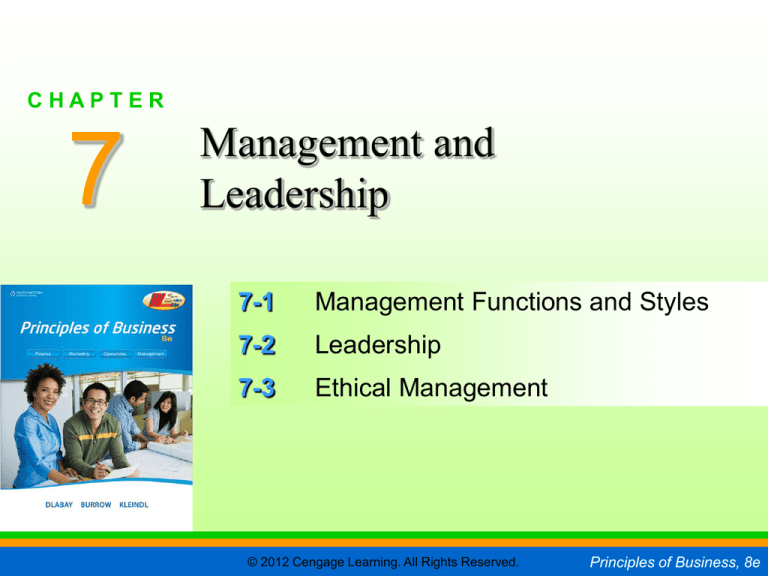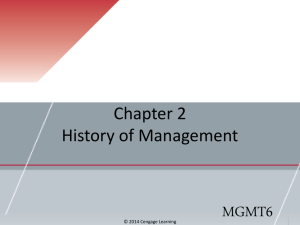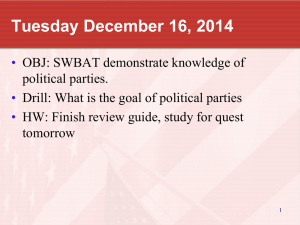
CHAPTER
7
SLIDE 1
CHAPTER
7
Management and
Leadership
7-1
Management Functions and Styles
7-2
Leadership
7-3
Ethical Management
© 2012 Cengage Learning. All Rights Reserved.
Principles of Business, 8e
7-1
Management
Functions and Styles
Goal 1 Define the five functions of
management.
Goal 2 Describe the levels of management
in businesses and organizations.
Goal 3 Discuss how and when to use the
two management styles.
© 2012 Cengage Learning. All Rights Reserved.
SLIDE 2
CHAPTER
7
SLIDE 3
KEY TERMS
● management
● planning
● organizing
● staffing
● implementing
● controlling
● management style
© 2012 Cengage Learning. All Rights Reserved.
Principles of Business, 8e
CHAPTER
ROLE AND WORK
OF MANAGERS
7
SLIDE 4
● Who is a manager?
● What do managers do?
● Planning
● Organizing
● Staffing
● Implementing
● Controlling
© 2012 Cengage Learning. All Rights Reserved.
Principles of Business, 8e
CHAPTER
Checkpoint
7
SLIDE 5
● What are the five management
functions?
● planning
● organizing
● staffing
● implementing
● controlling
© 2012 Cengage Learning. All Rights Reserved.
Principles of Business, 8e
CHAPTER
7
SLIDE 6
MANAGEMENT LEVELS
● Top management
● Middle management
● Supervisors
● Management by others
© 2012 Cengage Learning. All Rights Reserved.
Principles of Business, 8e
CHAPTER
7
SLIDE 7
Checkpoint
● What are the differences among the three
levels of management?
● Top-level managers are executives with
responsibilities for the direction and success of the
entire business.
● Middle managers are specialists with
responsibilities for specific parts of a company’s
operations.
● Supervisors are first-level managers who are
responsible for the work of a group of employees.
© 2012 Cengage Learning. All Rights Reserved.
Principles of Business, 8e
CHAPTER
7
SLIDE 8
MANAGEMENT STYLES
● Tactical management
● Strategic management
● Mixed management
© 2012 Cengage Learning. All Rights Reserved.
Principles of Business, 8e
CHAPTER
CHOOSING A
MANAGEMENT STYLE
© 2012 Cengage Learning. All Rights Reserved.
7
SLIDE 9
Principles of Business, 8e
CHAPTER
7
SLIDE 10
Checkpoint
● How is tactical management different from
strategic management?
● The tactical management style is more directive
and controlling than the strategic management
style.
● Using tactical management, the manager makes
the major decisions and supervises employees
closely to make sure the work is done well.
● In strategic management, managers are less
directive and involve employees in decisionmaking.
© 2012 Cengage Learning. All Rights Reserved.
Principles of Business, 8e
7-2
Leadership
Goal 1 Describe the need for leadership
skills and the characteristics of an
effective leader.
Goal 2 Identify the human relations skills
needed by managers and leaders.
Goal 3 Recognize four types of leadership
influence.
© 2012 Cengage Learning. All Rights Reserved.
SLIDE 11
CHAPTER
7
SLIDE 12
KEY TERMS
● leadership
● human relations
● influence
● informal influence
● formal influence
© 2012 Cengage Learning. All Rights Reserved.
Principles of Business, 8e
CHAPTER
7
SLIDE 13
WHAT IS LEADERSHIP?
● Ability to motivate individuals and groups
to accomplish important goals
● Need for leadership
● Leadership characteristics
© 2012 Cengage Learning. All Rights Reserved.
Principles of Business, 8e
CHAPTER
CHARACTERISTICS
OF EFFECTIVE LEADERS
●
●
●
●
●
●
Understanding
Initiative
Dependability
Judgment
Objectivity
Confidence
●
●
●
●
●
●
7
SLIDE 14
Stability
Cooperation
Honesty
Courage
Communication
Intelligence
© 2012 Cengage Learning. All Rights Reserved.
Principles of Business, 8e
CHAPTER
PREPARING TO BE
A LEADER
7
SLIDE 15
● Study leadership
● Participate in organizations and activities
● Practice leadership at work
● Observe leaders
● Work with a mentor
● Do a self-analysis and ask for feedback
© 2012 Cengage Learning. All Rights Reserved.
Principles of Business, 8e
CHAPTER
7
SLIDE 16
Checkpoint
● What are several ways to develop
leadership skills?
● Leadership skills can be developed through
studying leadership, participating in
organizations and activities, practicing
leadership at work, observing leaders,
working with a mentor, and doing a selfanalysis and asking for feedback.
© 2012 Cengage Learning. All Rights Reserved.
Principles of Business, 8e
CHAPTER
IMPORTANCE OF
HUMAN RELATIONS
7
SLIDE 17
● Human relations skills
● Self-understanding
● Understanding others
● Communication
● Team building
● Developing job satisfaction
© 2012 Cengage Learning. All Rights Reserved.
Principles of Business, 8e
CHAPTER
7
SLIDE 18
Checkpoint
● Why do managers and leaders need
effective human relations skills?
● Managers and leaders need effective
human relations skills because much of
their success depends on their ability to get
along well with all of the people with whom
they work and build effective work groups.
© 2012 Cengage Learning. All Rights Reserved.
Principles of Business, 8e
CHAPTER
7
SLIDE 19
INFLUENCING PEOPLE
● Kinds of influence
● Position influence
● Reward influence
● Expert influence
● Identity influence
● Formal and informal influence
© 2012 Cengage Learning. All Rights Reserved.
Principles of Business, 8e
CHAPTER
7
SLIDE 20
Checkpoint
● What is the difference between formal
and informal influence?
● Formal influence results from a position
that is a part of the organization’s structure.
● Informal influence results from personal
characteristics and is not a formal position
in the organization.
© 2012 Cengage Learning. All Rights Reserved.
Principles of Business, 8e
7-3
Ethical
Management
Goal 1 Justify the need for ethical
management.
Goal 2 Identify the role of leaders in
increasing ethical behavior.
© 2012 Cengage Learning. All Rights Reserved.
SLIDE 21
CHAPTER
7
SLIDE 22
KEY TERMS
● ethical business practices
● core values
© 2012 Cengage Learning. All Rights Reserved.
Principles of Business, 8e
CHAPTER
IMPORTANCE
OF ETHICAL BEHAVIOR
7
SLIDE 23
● Not everyone has the same belief about
what is ethical and what is not ethical.
● Organizations should develop a clear view
of what is acceptable business behavior
and what is not.
● Individuals and organizations develop
reputations based on their actions and the
decisions they make.
© 2012 Cengage Learning. All Rights Reserved.
Principles of Business, 8e
CHAPTER
WHAT IS
ETHICAL BEHAVIOR?
7
SLIDE 24
● It is lawful.
● It is consistent with company values and
policies.
● It is not intended to harm some so that
others can benefit.
● If the actions and results become public, it
will not embarrass the company.
© 2012 Cengage Learning. All Rights Reserved.
Principles of Business, 8e
CHAPTER
7
SLIDE 25
ETHICAL MANAGEMENT
● Actions and activities of the business are legal,
honest, and ethical.
● People and other companies treated fairly.
● Work of the company improves the communities
and countries in which it operates.
● Resources are used efficiently with
consideration of the effect on people and the
environment.
© 2012 Cengage Learning. All Rights Reserved.
Principles of Business, 8e
CHAPTER
7
SLIDE 26
Checkpoint
● What are the two parts of ethical
behavior?
● The actions of individuals and groups
● The results of those actions
© 2012 Cengage Learning. All Rights Reserved.
Principles of Business, 8e
CHAPTER
INCREASING ETHICAL BEHAVIOR
THROUGH LEADERSHIP
7
SLIDE 27
● Preparing the organization
● Modeling ethical behavior
© 2012 Cengage Learning. All Rights Reserved.
Principles of Business, 8e
CHAPTER
7
SLIDE 28
Checkpoint
● What are the core values of an
organization?
● An organization’s core values are the
principles that guide decisions and actions
in the company.
© 2012 Cengage Learning. All Rights Reserved.
Principles of Business, 8e












